Port Chicago – The Explosion
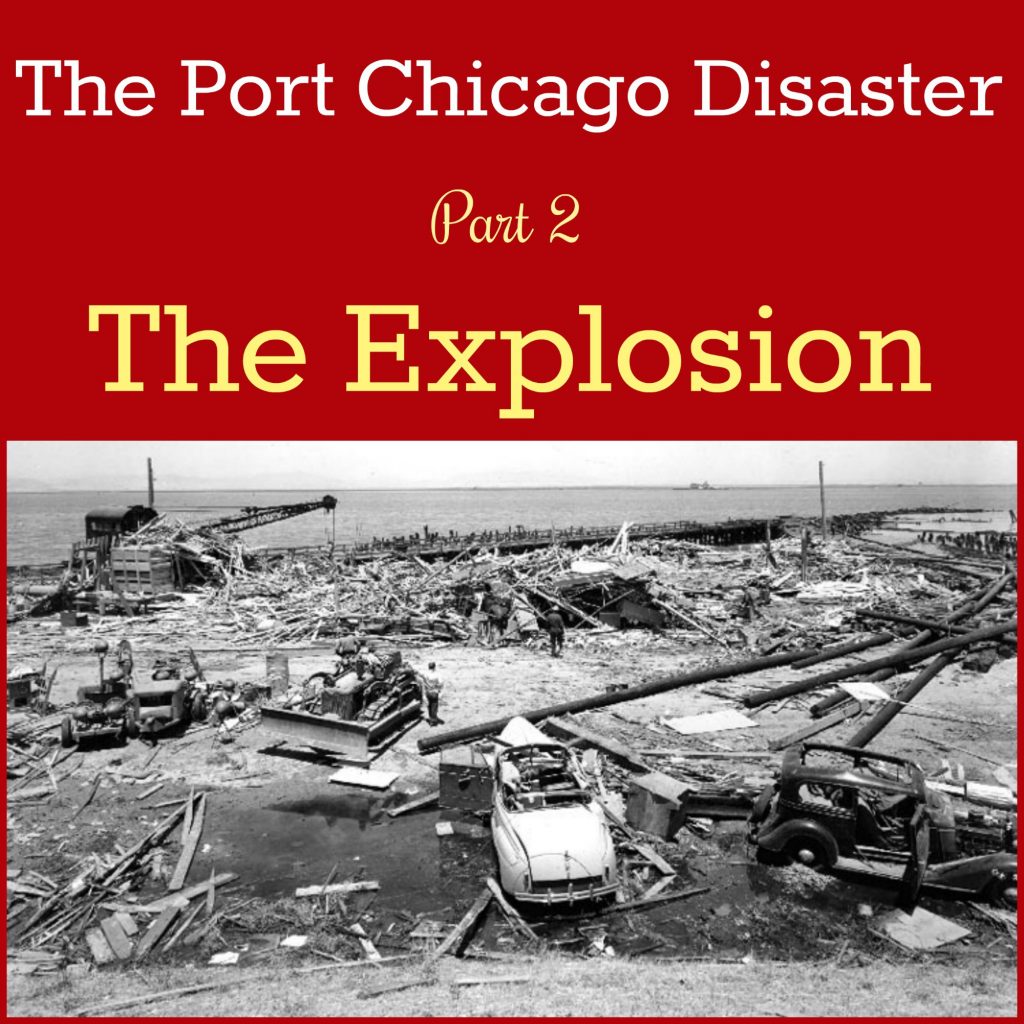
In the worst Home Front disaster of World War II, an explosion at the Naval Magazine in Port Chicago, California on July 17, 1944 killed 320 men, of whom 202 were black. The tragedy was followed by a work stoppage and a controversial mutiny trial. This sent ripples of change through the segregated armed forces.
I included these events in my novel Blue Skies Tomorrow.
This is the second in a five-part series on the Port Chicago Disaster:
Part 1: Introduction: Segregation in the armed forces and the situation at Port Chicago
Part 2: The explosion
Part 3: The work stoppage
Part 4: The mutiny trial
Part 5: The aftermath and desegregation of the US Navy
One Summer Night
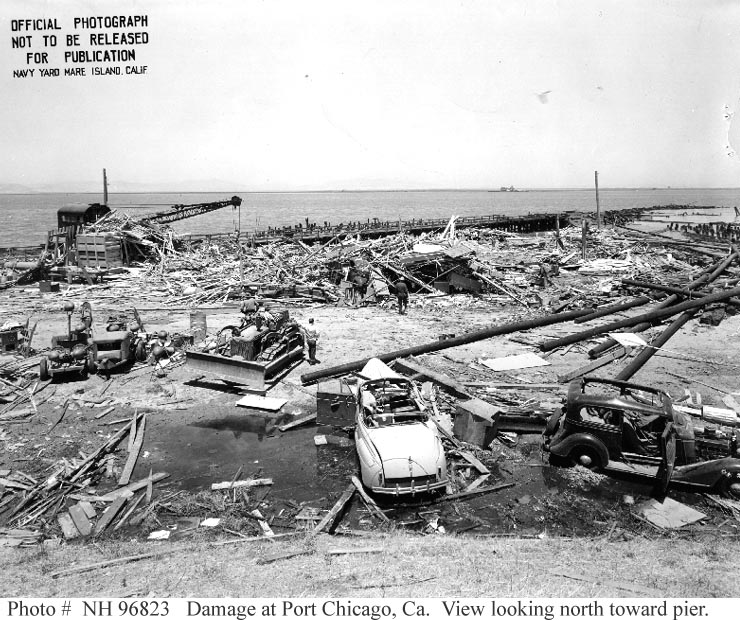
Damage at US Naval Magazine, Port Chicago from 17 July 1944 explosion. (US Naval History and Heritage Command)
The evening of Monday July 17 was cool, clear, and moonless. Down by Suisun Bay, where the Sacramento and San Joaquin Rivers merge, floodlights illuminated the docks at the U.S. Naval Magazine at Port Chicago, California.
The U.S. Navy in the Pacific depended on the ammunition loaded at Port Chicago, so men worked around the clock. For the night shift, two divisions of about one hundred black men each were hard at work loading two cargo ships from sixteen boxcars on the rails leading to the dock. Nine white officers and twenty-nine armed white Marine guards were also present, along with the crews of both ships and a Coast Guard fire barge moored nearby.
By 10 pm, the SS E.A. Bryan, a Liberty ship, had already been loaded with 4600 tons of cargo, including fuzed (live) 650-lb incendiary bombs, depth bombs, 1000-lb bombs, 40-mm shells, and fragmentation cluster bombs. The SS Quinault Victory (also spelled Quinalt), a brand-new Victory ship, had docked at 6 pm to be loaded starting at midnight for her maiden voyage. About 429 tons of explosives were on the docks or in the boxcars at 10 pm.
The Explosion
At 10:18 pm, two massive explosions occurred, seven seconds apart, equivalent to five kilotons of TNT, about the same magnitude as the atomic bomb dropped on Hiroshima. The first explosion appears to have happened on the dock area, and the second explosion was most likely the E.A. Bryan exploding as a whole.
A flash of bright orange, a sound like giant doors slamming, and a column of fire, smoke, and debris rose to over 12,000 feet. Exploding shells within the column of smoke produced effects like fireworks. An Army Air Force plane at 9000 feet reported seeing debris above its altitude.
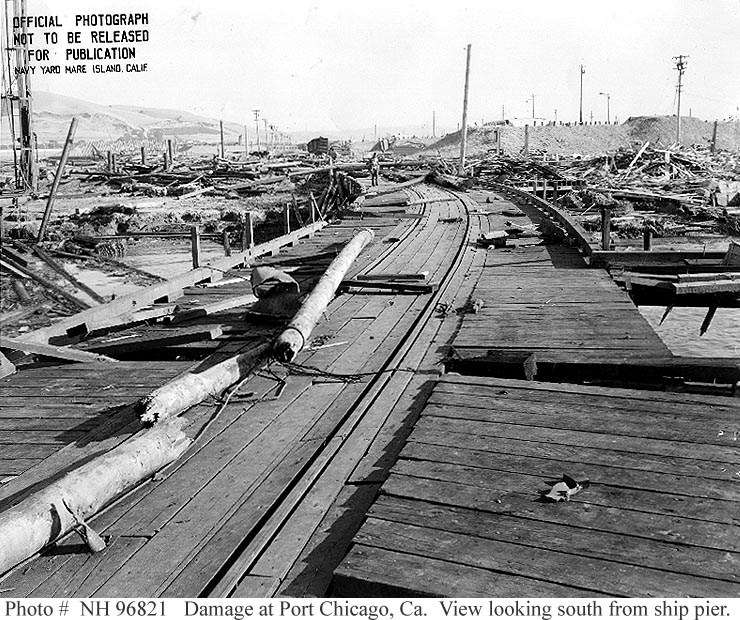
Damage on docks at US Naval Magazine, Port Chicago from 17 July 1944 explosion (US Naval History and Heritage Command)
The Damage
On the ships and docks, all 320 men present were killed instantly, 202 of whom were black. (News sources at the time reported the figure of 322 deaths; therefore, I used that figure in Blue Skies Tomorrow.) The E.A. Bryan completely disintegrated, and the Quinault Victory spun 180 degrees and snapped in two. The dock, locomotive, and boxcars disappeared.
Out on the river, two nearby boats were swamped by a thirty-foot wave, killing one, and the nearby Roe Island Lighthouse was seriously damaged.
On the base, every single building was damaged. The explosion knocked men off their feet and out of windows over a mile and a half away. In the town of Port Chicago, almost every home was damaged, but no one was killed. The explosion was felt within a 40-mile radius, as far away as San Francisco. Windows were blown out and plaster shaken down in Pittsburg, Antioch, Martinez, Benicia, and Vallejo.
About 390 people were injured, military and civilians. The most common injuries resulted from flying glass, including many who were blinded. The first explosion brought people to the windows to investigate, then the second explosion shattered the windows.
Some of those close to the explosion thought the Japanese were bombing. Those further away judged the rumbling and shaking as an earthquake.
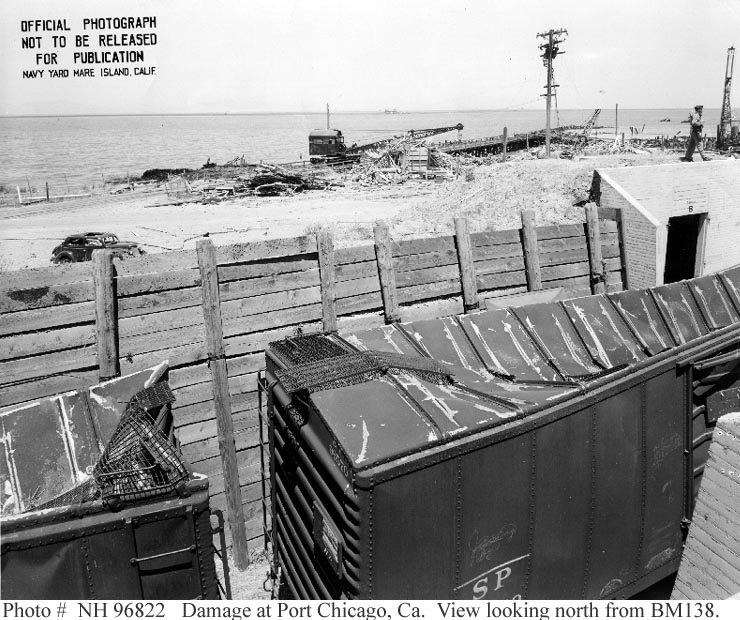
Damage to rail cars at US Naval Magazine, Port Chicago from 17 July 1944 explosion (US Naval History and Heritage Command)
Rescue Efforts
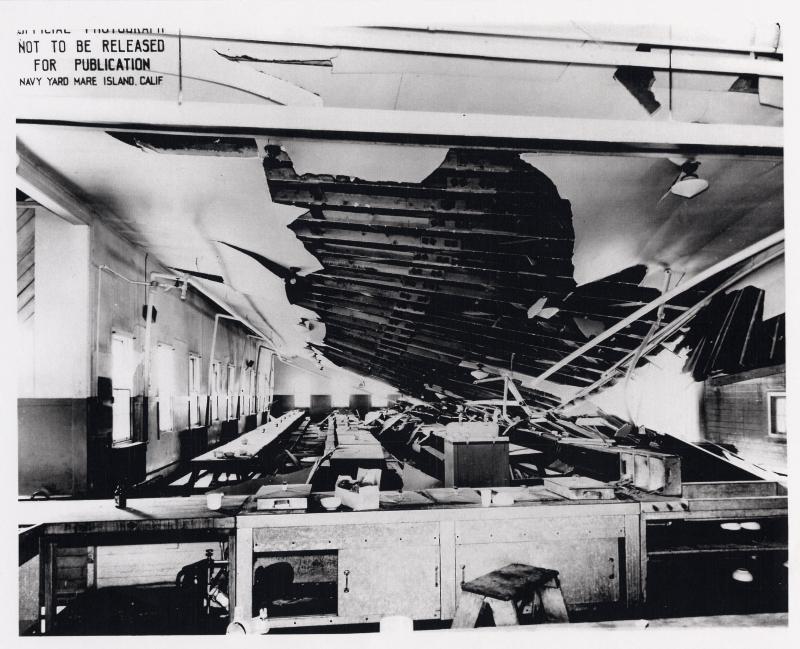
Damage at mess hall at US Naval Magazine, Port Chicago from 17 July 1944 explosion (US Naval History and Heritage Command)
On the base, the uninjured quickly and calmly rallied for search and rescue and first aid. Local military bases and civilian fire departments sprang to action. The first ambulances arrived within thirty minutes and transported the wounded to local hospitals. Local Red Cross, USO, and Salvation Army groups provided aid on the base and in the local communities.
Cause of the Explosion
Since every eyewitness to the explosion was killed, the exact cause of the explosion will never be determined. Poor training and leadership emphasized speed over safety, and faulty parts had been reported on several of the booms. Since fuzed incendiary bombs were being loaded, rough handling or an accident could easily have led to a dockside explosion, which then spread to the heavily loaded E.A. Bryan.
Continue Reading: Part 3: The work stoppage
Sources:
Allen, Robert L. The Port Chicago Mutiny. Berkeley CA: Heyday Books, 2006.
Port Chicago Naval Magazine Explosion on 17 July 1944: Court of Inquiry: Finding of Facts, Opinion and Recommendations. Washington DC: Department of the Navy, 30 October 1944. On Naval History and Heritage Command website. Accessed 25 June 2019.
Antioch Ledger, various articles, July 1944. Accessed on microfiche, Antioch Public Library, Antioch CA.


[…] and over the next few weeks, I’ll discuss the situation in the armed forces and at Port Chicago, the explosion, work stoppage, trial, and […]
[…] Tomorrow. Previous blog posts discussed the situation in the armed forces and at Port Chicago, the explosion, and the work stoppage. Today’s post covers the mutiny trial, and next week we’ll look at the […]
[…] Tomorrow. Previous blog posts discussed the situation in the armed forces and at Port Chicago, and the explosion, today I’ll cover the work stoppage, and over the next couple of weeks we’ll look at the trial, […]
My wife’s mother was living in Concord at the time of the explosions and she related that all the house windows were blown out but fortunately no family members were hurt. The four kids were teens but had vivid memories of this event. My wife’s dad heard it clear over in El Campo next to Lodi which is about 40-50 miles away.
Wow! That would have been memorable.
[…] 2) The explosion […]